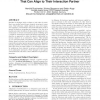66 search results - page 11 / 14 » Adapting acoustic and lexical models to dysarthric speech |
LREC
2010
15 years 1 months ago
2010
Due to upcoming mobile telephony services with higher speech quality, a wideband (50 Hz to 7 kHz) mobile telephony derivative of TIMIT has been recorded called WTIMIT. It allows a...
98
Voted
HCI
2009
14 years 10 months ago
2009
Abstract. Although older people are an important user group for smart environments, there has been relatively little work on adapting natural language interfaces to their requireme...
105
click to vote
JCST
2006
15 years 9 days ago
2006
Abstract A framework for dialectal Chinese speech recognition is proposed and studied, in which a relatively small dialectal Chinese (or in other words Chinese influenced by the na...
ICASSP
2011
IEEE
14 years 4 months ago
2011
IEEE
The use of speaker adaptation transforms as features for speaker recognition is an appealing alternative to conventional short-term cepstral features. In general, this kind of met...
108
click to vote
ATAL
2010
Springer
15 years 1 months ago
2010
Springer
Speakers in dialogue tend to adapt to each other by starting to use similar lexical items, syntactic structures, or gestures. This behaviour, called alignment, may serve important...

